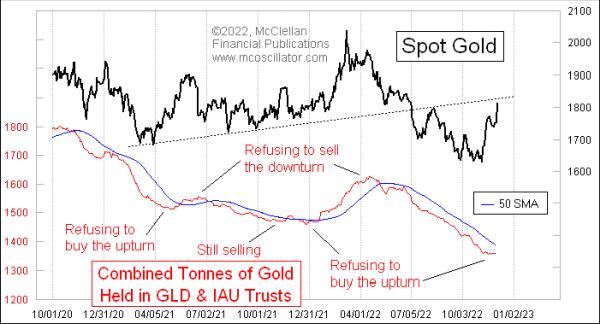
Gold prices have moved up by almost $200 off the October lows. Generally, that would bring a response from investors to start buying into SPDR Gold Shares (GLD) and iShares Gold Trust (IAU), the big gold bullion exchange-traded funds (ETFs). But they're not doing that (yet), which is really interesting.
The normal behavior by investors is to buy into these ETFs when gold is rising, then sell out of them when gold prices fall. Extremes of either buying or selling can be useful indications of a sentiment extreme, worthy of a top or bottom for prices. That's how things normally work.
What is happening now is not normal. Gold futures have been rising, with a greater than 2% jump on December 1, 2022 thanks to a little bit of U.S. dollar weakness. But up through November 30 (the most recent data available), there has not been any response by investors trying to reposition themselves into these ETFs.
Both GLD and IAU hold gold bullion to back their shares. If the shares trade at a price significantly different from the net asset value (NAV), then these funds will issue or redeem shares as needed to get the trading price back close to the NAV. When the funds do that, the total asset levels will change.
The sponsors report these data after the close each day at the following links:
Given the big jump in gold prices since October, we should expect that public sentiment toward gold should be turning more bullish, but it isn't. Investors are still avoiding these ETFs, which means that their bearishness is more firmly rooted. That is actually bullish for gold prices, because, to get a top for gold prices, we would expect to see investors clamoring to get into gold. They are not at that point yet, which conveys the message that gold is going to have to trend higher for a lot longer to get the sentiment to change.
